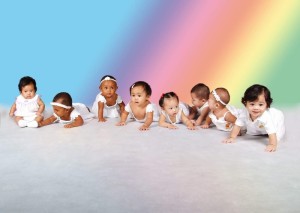Brain and Visual Development in Babies
A newborn baby takes approximately four months to gain the ability to properly focus their eyes. Yet presenting visual stimulation to children from birth helps more than just eyesight – it initiates early brain development that will benefit them throughout their lifetimes.
Very quickly, newborns gain visual clarity for objects approximately 15 cm from their eyes, the approximate distance of a mother’s face when breastfeeding. They begin to recognize their mother’s face from very early on, and display a clear preference, comfort, and facility with face-shaped arrangement of objects.
As a baby’s vision matures during the first few months of life, they will focus on sharp edges between contrasting colours as they develop visual acuity. Objects that are the subject of babies’ visual attention stimulate nerve cells and have an impact on how a baby begins to make sense of the world.
Early development of visual acuity has far-reaching and lasting effects throughout a child’s development. More than 80% of information processed by the brain is visual, and babies who receive visual stimulation from an early age make more neural connections. Young children who build and exercise these brain connections are better able to learn new things throughout their early development.
Repeated exposure to distinct objects and shapes creates memories that can be retrieved through strongly formed neural connection pathways. This learning and retrieval of information process helps develop brain cognition and creates neuronal connections fostering brain development. A baby’s ability to track moving objects develops quickly– babies can begin to focus on bigger and closer objects, ideally with bright colours in contrast to their background.
Demonstrating slow-moving objects moving along a predictable, smooth path helps very young babies develop their visual tracking skills. As they master these skills, smaller objects can be introduced. Movements can increase in complexity and begin to vary in predictability as a child’s awareness, skill and curiosity increases.
Once a baby’s eyesight has developed to distinguish increasingly detailed stimuli, they become fascinated by repeated patterns. Researchers believe that developing anticipation through pattern repetition aids in developing memory and predictive abilities. As visual skills are refined, they in turn help babies with development of motor skills and hand-eye coordination.
Vision is one of the least developed senses at birth, so providing your baby with visual stimuli during the early months of life may have the most profound impact on your child’s brain development.
